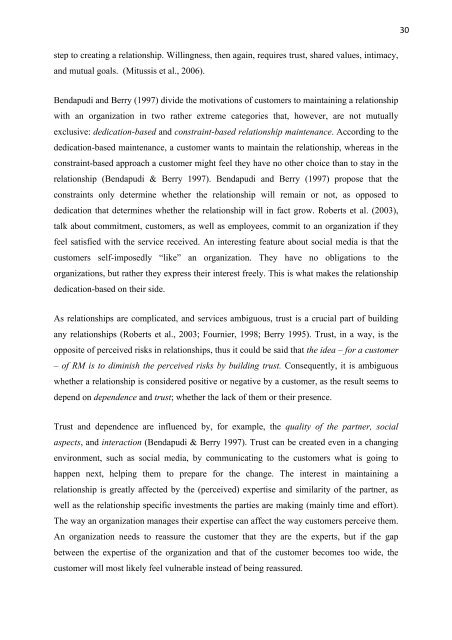Is there more to it than posting a status update?
Is there more to it than posting a status update?
Is there more to it than posting a status update?
You also want an ePaper? Increase the reach of your titles
YUMPU automatically turns print PDFs into web optimized ePapers that Google loves.
step <strong>to</strong> creating a relationship. Willingness, then again, requires trust, shared values, intimacy,<br />
and mutual goals. (M<strong>it</strong>ussis et al., 2006).<br />
Bendapudi and Berry (1997) divide the motivations of cus<strong>to</strong>mers <strong>to</strong> maintaining a relationship<br />
w<strong>it</strong>h an organization in two rather extreme categories that, however, are not mutually<br />
exclusive: dedication-based and constraint-based relationship maintenance. According <strong>to</strong> the<br />
dedication-based maintenance, a cus<strong>to</strong>mer wants <strong>to</strong> maintain the relationship, whereas in the<br />
constraint-based approach a cus<strong>to</strong>mer might feel they have no other choice <strong>than</strong> <strong>to</strong> stay in the<br />
relationship (Bendapudi & Berry 1997). Bendapudi and Berry (1997) propose that the<br />
constraints only determine whether the relationship will remain or not, as opposed <strong>to</strong><br />
dedication that determines whether the relationship will in fact grow. Roberts et al. (2003),<br />
talk about comm<strong>it</strong>ment, cus<strong>to</strong>mers, as well as employees, comm<strong>it</strong> <strong>to</strong> an organization if they<br />
feel satisfied w<strong>it</strong>h the service received. An interesting feature about social media is that the<br />
cus<strong>to</strong>mers self-imposedly “like” an organization. They have no obligations <strong>to</strong> the<br />
organizations, but rather they express their interest freely. This is what makes the relationship<br />
dedication-based on their side.<br />
As relationships are complicated, and services ambiguous, trust is a crucial part of building<br />
any relationships (Roberts et al., 2003; Fournier, 1998; Berry 1995). Trust, in a way, is the<br />
oppos<strong>it</strong>e of perceived risks in relationships, thus <strong>it</strong> could be said that the idea – for a cus<strong>to</strong>mer<br />
– of RM is <strong>to</strong> diminish the perceived risks by building trust. Consequently, <strong>it</strong> is ambiguous<br />
whether a relationship is considered pos<strong>it</strong>ive or negative by a cus<strong>to</strong>mer, as the result seems <strong>to</strong><br />
depend on dependence and trust; whether the lack of them or their presence.<br />
Trust and dependence are influenced by, for example, the qual<strong>it</strong>y of the partner, social<br />
aspects, and interaction (Bendapudi & Berry 1997). Trust can be created even in a changing<br />
environment, such as social media, by communicating <strong>to</strong> the cus<strong>to</strong>mers what is going <strong>to</strong><br />
happen next, helping them <strong>to</strong> prepare for the change. The interest in maintaining a<br />
relationship is greatly affected by the (perceived) expertise and similar<strong>it</strong>y of the partner, as<br />
well as the relationship specific investments the parties are making (mainly time and effort).<br />
The way an organization manages their expertise can affect the way cus<strong>to</strong>mers perceive them.<br />
An organization needs <strong>to</strong> reassure the cus<strong>to</strong>mer that they are the experts, but if the gap<br />
between the expertise of the organization and that of the cus<strong>to</strong>mer becomes <strong>to</strong>o wide, the<br />
cus<strong>to</strong>mer will most likely feel vulnerable instead of being reassured.<br />
30















